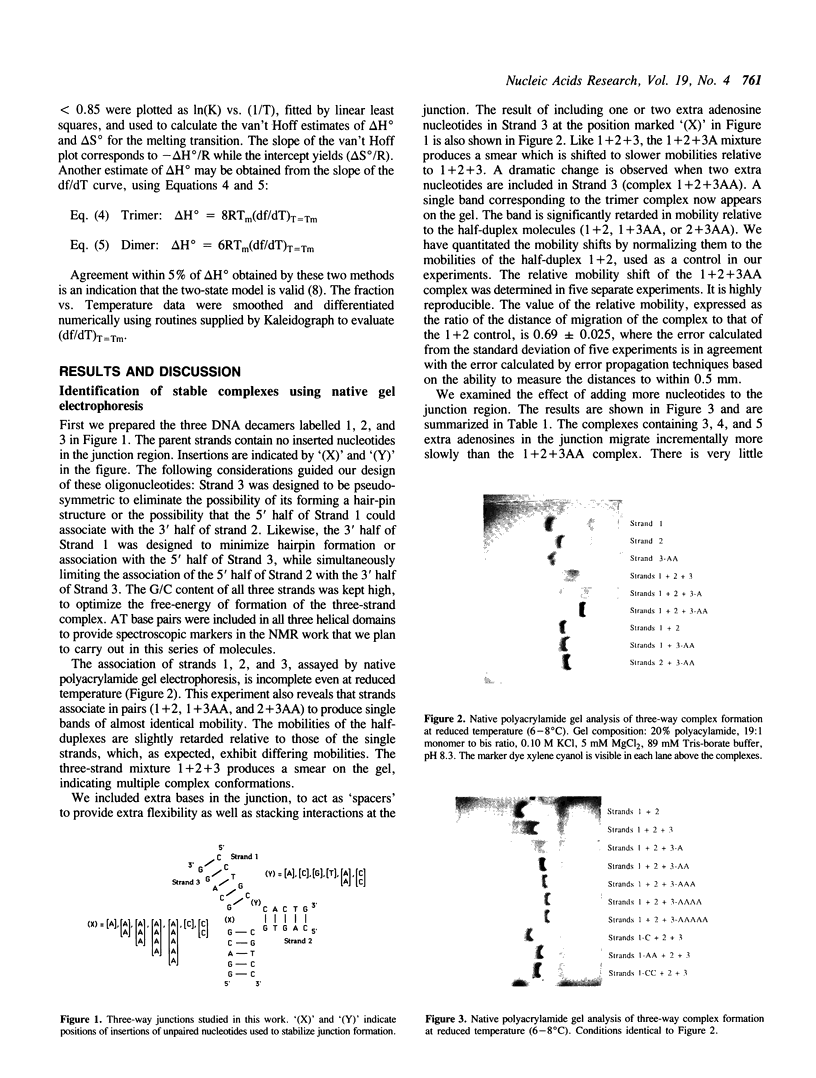Abstract
Non-paired nucleotides stabilize the formation of three-way helical DNA junctions. Two or more unpaired nucleotides located in the junction region enable oligomers ten to fifteen nucleotides long to assemble, forming conformationally homogeneous junctions, as judged by native gel electrophoresis. The unpaired bases can be present on the same strand or on two different strands. Up to five extra bases on one strand have been tested and found to produce stable junctions. The formation of stable structures is favored by the presence of a divalent cation such as magnesium and by high monovalent salt concentration. The order-disorder transition of representative three-way junctions was monitored optically in the ultraviolet and analyzed to quantify thermodynamically the stabilization provided by unpaired bases in the junction region. We report the first measurements of the thermodynamics of adding an unpaired nucleotide to a nucleic acid three-way junction. We find that delta delta G degrees (37 degrees C) = +0.5 kcal/mol for increasing the number of unpaired adenosines from two to three. Three-way junctions having reporter arms 40 base-pairs long were also prepared. Each of the three reporter arms contained a unique restriction site 15 base-pairs from the junction. Asymmetric complexes produced by selectively cleaving each arm were analyzed on native gels. Cleavage of the double helical arm opposite the strand having the two extra adenosines resulted in a complex that migrated more slowly than complexes produced by cleavage at either of the other two arms. It is likely that the strand containing the unpaired adenosines is kinked at an acute angle, forming a Y-shaped, rather than a T-shaped junction.
Full text
PDF







Images in this article
Selected References
These references are in PubMed. This may not be the complete list of references from this article.
- Breslauer K. J., Frank R., Blöcker H., Marky L. A. Predicting DNA duplex stability from the base sequence. Proc Natl Acad Sci U S A. 1986 Jun;83(11):3746–3750. doi: 10.1073/pnas.83.11.3746. [DOI] [PMC free article] [PubMed] [Google Scholar]
- Cooper J. P., Hagerman P. J. Gel electrophoretic analysis of the geometry of a DNA four-way junction. J Mol Biol. 1987 Dec 20;198(4):711–719. doi: 10.1016/0022-2836(87)90212-9. [DOI] [PubMed] [Google Scholar]
- Duckett D. R., Lilley D. M. The three-way DNA junction is a Y-shaped molecule in which there is no helix-helix stacking. EMBO J. 1990 May;9(5):1659–1664. doi: 10.1002/j.1460-2075.1990.tb08286.x. [DOI] [PMC free article] [PubMed] [Google Scholar]
- Jin R. Z., Breslauer K. J., Jones R. A., Gaffney B. L. Tetraplex formation of a guanine-containing nonameric DNA fragment. Science. 1990 Oct 26;250(4980):543–546. doi: 10.1126/science.2237404. [DOI] [PubMed] [Google Scholar]
- Landy A. Dynamic, structural, and regulatory aspects of lambda site-specific recombination. Annu Rev Biochem. 1989;58:913–949. doi: 10.1146/annurev.bi.58.070189.004405. [DOI] [PubMed] [Google Scholar]
- Longfellow C. E., Kierzek R., Turner D. H. Thermodynamic and spectroscopic study of bulge loops in oligoribonucleotides. Biochemistry. 1990 Jan 9;29(1):278–285. doi: 10.1021/bi00453a038. [DOI] [PubMed] [Google Scholar]
- Ma R. I., Kallenbach N. R., Sheardy R. D., Petrillo M. L., Seeman N. C. Three-arm nucleic acid junctions are flexible. Nucleic Acids Res. 1986 Dec 22;14(24):9745–9753. doi: 10.1093/nar/14.24.9745. [DOI] [PMC free article] [PubMed] [Google Scholar]
- Marky L. A., Breslauer K. J. Calculating thermodynamic data for transitions of any molecularity from equilibrium melting curves. Biopolymers. 1987 Sep;26(9):1601–1620. doi: 10.1002/bip.360260911. [DOI] [PubMed] [Google Scholar]
- Marky L. A., Kallenbach N. R., McDonough K. A., Seeman N. C., Breslauer K. J. The melting behavior of a DNA junction structure: a calorimetric and spectroscopic study. Biopolymers. 1987 Sep;26(9):1621–1634. doi: 10.1002/bip.360260912. [DOI] [PubMed] [Google Scholar]
- Puglisi J. D., Tinoco I., Jr Absorbance melting curves of RNA. Methods Enzymol. 1989;180:304–325. doi: 10.1016/0076-6879(89)80108-9. [DOI] [PubMed] [Google Scholar]
- Turner D. H., Sugimoto N., Freier S. M. RNA structure prediction. Annu Rev Biophys Biophys Chem. 1988;17:167–192. doi: 10.1146/annurev.bb.17.060188.001123. [DOI] [PubMed] [Google Scholar]








